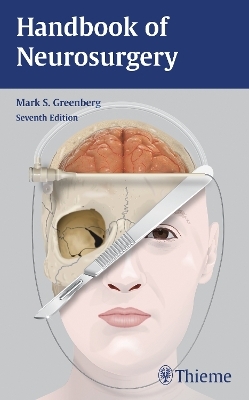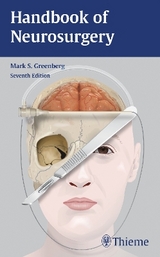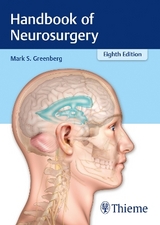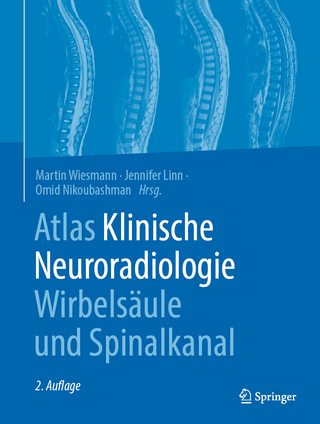Handbook of Neurosurgery
Thieme Medical Publishers Inc (Verlag)
978-1-60406-326-4 (ISBN)
- Titel ist leider vergriffen;
keine Neuauflage - Artikel merken
"A 'must-have'...[a] low-cost, highly portable, and extremely useful reference volume, which will undoubtedly enjoy continued longevity into the foreseeable future." --Journal of Neurosurgery "A vital resource...For rapid access to the diagnosis and management of all neurosurgical things, there is no substitute."--The Journal of TRAUMA(R) Injury, Infection, and Critical Care For two decades, Handbook of Neurosurgery -- now in a fully updated seventh edition -- has been an invaluable companion for every neurosurgery resident and nurse, as well as neurologists and others involved in the care of patients with brain and spine disorders. Dr. Greenberg's classic text covers the breadth of neurosurgery and its allied specialties and provides the latest information on anatomy and physiology, differential diagnosis, and currently accepted principles of clinical management. Renowned for its scope and accessibility, this portable, single-volume guide is packed with more than 1,300 pages of practical information, including thousands of literature citations, handy cross-references, and a thorough index.
Features: *New to the seventh edition: detailed coverage of blunt cervical arterial injuries; awake craniotomies; brain mapping; new grading systems for cervical and thoracolumbar fractures; radiation safety for neurosurgeons; organ donation after cardiac death; and expanded discussion of endovascular techniques * Numerous updates, including information on dural arteriovenous malformations; tumors and molecular biology; and new neuromonitoring modalities such as brain oxygen tension, cerebral microdialysis, and regional cerebral blood flow * The return of basic surgical material to acquaint readers with the operating room * A practical new feature called Booking the Case supplies helpful information about scheduling surgery and obtaining informed consent * Highly valuable section on hot topics in neurocritical care * Color highlights and full-color inserts to enhance readability Comprehensive and conveniently compact, this book is a must-have reference for neurosurgery residents and a useful tool for anyone working in the clinical neurosciences.
Assistant Professor of Neurosurgery, Dept. of Neurosurgery, University of South Florida, Tampa, FL, USA
Contributors iii Evidence based medicine iv Booking the case v Abbreviations vi 1. Neuroanesthesia 1 1.1. General information 1 1.2. Drugs used in neuroanesthesia 1 1.3. Anesthetic requirements for intraoperative evoked potential monitoring 4 1.4. Malignant hyperthermia 5 1.5. References 6 2. Neurocritical care 7 2.1. Fluids and Electrolytes 7 2.2. Blood pressure management 19 2.3. Sedatives & paralytics 23 2.4. Neurogenic pulmonary edema 28 2.5. References 28 3. General care 31 3.1. Endocrinology 31 3.2. Hematology 34 3.3. Pharmacology 44 3.4. References 53 4. Neurology 56 4.1. Dementia 56 4.2. Headache 57 4.3. Parkinsonism 59 4.4. Multiple sclerosis 61 4.5. Motor neuron diseases 65 4.6. Guillain-Barre syndrome 66 4.7. Myelitis 69 4.8. Neurosarcoidosis 71 4.9. Vascular dysautoregulatory encephalopathy 73 4.10. Vasculitis and vasculopathy 74 4.11. References 80 5. Neuroanatomy and physiology 84 5.1. Surface anatomy 84 5.2. Cranial foramina & their contents 89 5.3. Cerebellopontine angle anatomy 90 5.4. Occiptoatlantoaxial-complex anatomy 91 5.5. Spinal cord anatomy 92 5.6. Cerebrovascular anatomy 96 5.7. Internal capsule 107 5.8. Miscellaneous 108 5.9. Neurophysiology 109 5.10. References 119 6. Neuroradiology 122 6.1. Contrast agents in neuroradiology 122 6.2. Radiation safety for neurosurgeons 126 6.3. CAT scan or CT scan 128 6.4. Magnetic resonance imaging (MRI) 129 6.5. Angiography (cerebral) 134 6.6. Plain films 135 6.7. Myelography 140 6.8. Radionuclide scanning 140 6.9. References 141 7. Operations and procedures 144 7.1. Intraoperative dyes 144 7.2. Operating room equipment 144 7.3. Surgical hemostasis 146 7.4. Craniotomies 146 7.5. Cranioplasty 173 7.6. Localizing levels in spine surgery 173 7.7. Anterior approaches to the spine 174 7.8. Surgical fusion of the cervical spine 179 7.9. Surgical fusion of the thoracic spine 190 7.10. Surgical fusion of the lumbar and lumbosacral spine 191 7.11. Bone graft 197 7.12. Percutaneous access to the CSF 201 7.13. CSF diversionary procedures 207 7.14. Sural nerve biopsy 214 7.15. Nerve blocks 215 7.16. References 217 8. Developmental anomalies 222 8.1. Arachnoid cysts 222 8.2. Intracranial lipomas 225 8.3. Hypothalamic hamartomas 226 8.4. Neurenteric cysts 227 8.5. Craniofacial development 228 8.6. Chiari malformation 233 8.7. Dandy Walker malformation 240 8.8. Aqueductal stenosis 241 8.9. Neural tube defects 243 8.10. Absence of the septum pellucidum 247 8.11. Klippel-Feil syndrome 253 8.12. Tethered cord syndrome 254 8.13. Split cord malformation 256 8.14. Lumbosacral nerve root anomalies 256 8.15. References 257 9. Neuroendovascular intervention 262 9.1. Neuroendovascular procedure basics 263 9.2. References 264 10. Electrodiagnostics 266 10.1. Electroencephalogram (EEG) 266 10.2. Evoked potentials 266 10.3. NCS/EMG 269 10.4. References 271 11. Neurotoxicology 273 11.1. Ethanol 273 11.2. Opioids 275 11.3. Cocaine 276 11.4. Amphetamines 277 11.5. Carbon monoxide 277 11.6. References 278 12. Coma 279 12.1. General information 279 12.2. Approach to the comatose patient 281 12.3. Herniation syndromes 284 12.4. Hypoxic coma 287 12.5. References 288 13. Brain death 289 13.1. Brain death in adults 289 13.2. Brain death in children 292 13.3. Organ and tissue donation 293 13.4. References 296 14. Cerebrospinal fluid 297 14.1. General information 297 14.2. CSF constituents 297 14.3. Artificial CSF 300 14.4. CSF fistula (cranial) 300 14.5. Intracranial hypotension 305 14.6. References 306 15. Hydrocephalus 307 15.1. Treatment of hydrocephalus 314 15.2. Shunt problems 321 15.3. Normal pressure hydrocephalus 329 15.4. Blindness from hydrocephalus 335 15.5. Hydrocephalus and pregnancy 336 15.6. References 337 16. Infections 342 16.1. Prophylactic antibiotics 342 16.2. Meningitis 343 16.3. Shunt infection 345 16.4. Wound infections 348 16.5. Osteomyelitis of the skull 349 16.6. Cerebral abscess 350 16.7. Subdural empyema 356 16.8. Viral encephalitis 358 16.9. Creutzfeldt-Jakob disease 361 16.10. Neurologic manifestations of AIDS 364 16.11. Lyme disease - neurologic manifestations 368 16.12. Parasitic infections of the CNS 369 16.13. Fungal infections of the CNS 374 16.14. Amebic infections of CNS 375 16.15. Spine infections 376 16.16. References 388 17. Seizures 394 17.1. Seizure classification 394 17.2. Special types of seizures 396 17.3. Status epilepticus 402 17.4. Antiepileptic drugs (AEDs) 407 17.5. Seizure surgery 420 17.6. References 425 18. Spine & spinal cord 428 18.1. Low back pain and radiculopathy 428 18.2. Sagittal balance 441 18.3. Intervertebral disc herniation 442 18.4. Degenerative disc/spine disease 474 18.5. Craniocervical junction and upper cervical spine abnormalities 494 18.6. Rheumatoid arthritis 494 18.7. Atlantoaxial subluxation (AAS) in Down syndrome 498 18.8. Paget s disease 498 18.9. Ankylosing spondylitis 502 18.10. Ossification of the posterior longitudinal ligament (OPLL) 504 18.11. Ossification of the anterior longitudinal ligament (OALL) 506 18.12. Diffuse idiopathic skeletal hyperostosis 506 18.13. Scheuermann's kyphosis 506 18.14. Spinal vascular malformations 507 18.15. Spinal meningeal cysts 509 18.16. Syringomyelia 510 18.17. Spinal cord herniation (idiopathic) 514 18.18. Spinal epidural hematoma 515 18.19. Spinal subdural hematoma 515 18.20. Spinal epidural lipomatosis (SEL) 516 18.21. Coccydynia 516 18.22. References 517 19. Functional neurosurgery 532 19.1. Deep brain stimulation 532 19.2. Surgical treatment of Parkinson s disease 532 19.3. Dystonia 536 19.4. Spasticity 536 19.5. Torticollis 541 19.6. Neurovascular compression syndromes 542 19.7. Hyperhidrosis 544 19.8. Tremor 545 19.9. Sympathectomy 545 19.10. References 546 20. Pain 548 20.1. Neuropathic pain syndromes 548 20.2. Craniofacial pain syndromes 549 20.3. Postherpetic neuralgia 564 20.4. Pain procedures 567 20.5. Complex regional pain syndrome (CRPS) 576 20.6. References 577 21. Tumor 582 21.1. General information 582 21.2. Primary brain tumors 590 21.3. Pediatric brain tumors 697 21.4. Skull tumors 698 21.5. Cerebral metastases 702 21.6. Carcinomatous meningitis 711 21.7. Foramen magnum tumors 711 21.8. Idiopathic intracranial hypertension (IIH) 713 21.9. Empty sella syndrome 719 21.10. Tumor markers 720 21.11. Neurocutaneous disorders 722 21.12. Tumors of the spine and spinal cord 728 21.13. Neuroblastomas 748 21.14. References 749 22. Radiation therapy (XRT) 770 22.1. Conventional external beam radiation 770 22.2. Stereotactic radiosurgery & radiotherapy 773 22.3. Interstitial brachytherapy 779 22.4. References 779 23. Stereotactic surgery 782 23.1. References 783 24. Peripheral nerves 786 24.1. Some basic points about peripheral nerve injury/surgery 789 24.2. Brachial plexus 790 24.3. Peripheral neuropathies 793 24.4. Thoracic outlet syndrome 822 24.5. Miscellaneous peripheral nerve 824 24.6. References 824 25. Neurophthalmology 828 25.1. Nystagmus 828 25.2. Papilledema 828 25.3. Visual fields 829 25.4. Pupillary diameter 829 25.5. Extraocular muscle (EOM) system 834 25.6. Miscellaneous neurophthalmologic signs 838 25.7. References 839 26. Neurotology 840 26.1. Dizziness and vertigo 840 26.2. Meniere s disease 842 26.3. Facial nerve palsy 844 26.4. Hearing loss 848 26.5. References 849 27. Head trauma 850 27.1. Transfer of trauma patients 854 27.2. Management in E/R 855 27.3. Neuromonitoring 866 27.4. Skull fractures 885 27.5. Posttraumatic parenchymal injuries 892 27.6. Epidural hematoma 894 27.7. Subdural hematoma 896 27.8. Traumatic posterior fossa mass lesions 905 27.9. Posttraumatic hydrocephalus 906 27.10. Aspects of general care in severe TBI 907 27.11. Outcome from head trauma 908 27.12. Gunshot wounds to the head 912 27.13. Non-missile penetrating trauma 916 27.14. High altitude cerebral edema 916 27.15. Pediatric head injury 917 27.16. References 919 28. Spine injuries 930 28.1. Whiplash-associated disorders 931 28.2. Pediatric spine injuries 932 28.3. Initial management of spinal cord injury 933 28.4. Neurological assessment 944 28.5. Spinal cord injuries 948 28.6. Cervical spine fractures 951 28.7. Blunt cerebrovascular injuries 982 28.8. Thoracic & lumbar spine fractures 986 28.9. Osteoporotic spine fractures 992 28.10. Sacral fractures 997 28.11. Gunshot wounds to the spine 998 28.12. Penetrating trauma to the neck 998 28.13. Delayed deterioration following spinal cord injuries 1000 28.14. Chronic management issues with spinal cord injuries 1000 28.15. References 1002 29. Stroke 1010 29.1. Cerebrovascular hemodynamics 1010 29.2. Strokes: general information 1011 29.3. Stroke in young adults 1024 29.4. Lacunar strokes 1026 29.5. Collateral circulation 1027 29.6. "Occlusion" syndromes 1027 29.7. Miscellaneous stroke 1029 29.8. References 1030 30. SAH and aneurysms 1034 30.1. Introduction to SAH 1034 30.2. Grading SAH 1039 30.3. Initial management of SAH 1040 30.4. Vasospasm 1045 30.5. Cerebral aneurysms 1055 30.6. Treatment options for aneurysms 1057 30.7. Timing of aneurysm surgery 1060 30.8. General technical considerations of aneurysm surgery 1061 30.9. Aneurysm recurrence after treatment 1065 30.10. Aneurysm type by location 1066 30.11. Post-op orders for aneurysm clipping 1076 30.12. Unruptured aneurysms 1077 30.13. Multiple aneurysms 1080 30.14. Familial aneurysms 1080 30.15. Traumatic aneurysms 1081 30.16. Mycotic aneurysms 1082 30.17. Giant aneurysms 1082 30.18. SAH of unknown etiology 1083 30.19. Nonaneurysmal SAH 1084 30.20. Pregnancy & intracranial hemorrhage 1086 30.21. References 1087 31. Vascular malformations 1098 31.1. Arteriovenous malformation 1098 31.2. Venous angiomas 1104 31.3. Angiographically occult vascular malformations 1105 31.4. Dural AVM 1109 31.5. Vein of Galen malformation 1112 31.6. Carotid-cavernous fistula 1113 31.7. References 1114 32. Intracerebral hemorrhage 1118 32.1. Intracerebral hemorrhage in adults 1118 32.2. ICH in young adults 1131 32.3. Intracerebral hemorrhage in the newborn 1131 32.4. References 1138 33. Occlusive cerebro-vascular disease 1144 33.1. Atherosclerotic cerebrovascular disease 1144 33.2. Cerebral arterial dissections 1160 33.3. Extracranial-intracranial (EC/IC) bypass 1165 33.4. Cerebrovascular venous thrombosis 1166 33.5. Moyamoya disease 1170 33.6. References 1174 34. Outcome assessment 1182 34.1. References 1184 35. Differential diagnosis 1185 35.1. Differential diagnosis (DDx) by signs and symptoms 1185 35.2. Differential diagnosis (DDx) by location 1209 35.3. References 1235 36. Index 1240 Quick reference tables 1331
| Erscheint lt. Verlag | 18.4.2023 |
|---|---|
| Zusatzinfo | 132 |
| Verlagsort | New York |
| Sprache | englisch |
| Maße | 128 x 205 mm |
| Gewicht | 778 g |
| Themenwelt | Medizinische Fachgebiete ► Chirurgie ► Neurochirurgie |
| ISBN-10 | 1-60406-326-2 / 1604063262 |
| ISBN-13 | 978-1-60406-326-4 / 9781604063264 |
| Zustand | Neuware |
| Informationen gemäß Produktsicherheitsverordnung (GPSR) | |
| Haben Sie eine Frage zum Produkt? |
aus dem Bereich





